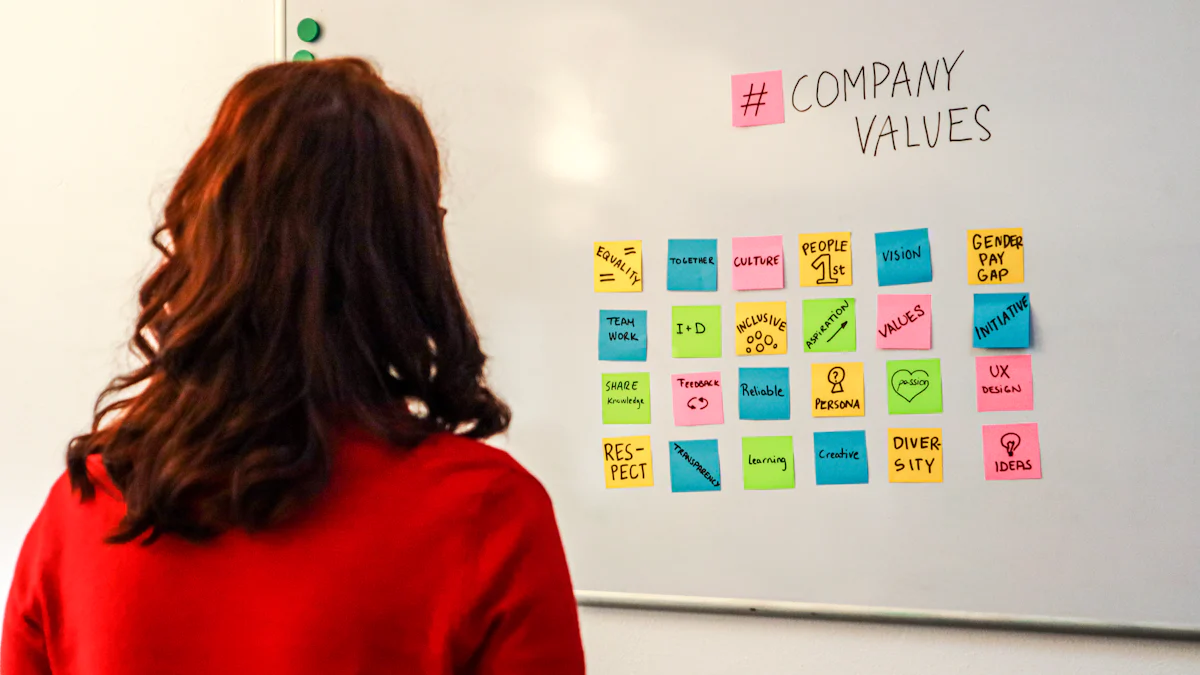Steps to Develop a Lean Culture for Sustainable Growth

Developing a lean culture is essential for achieving sustainable growth in today’s competitive landscape. By focusing on eliminating waste and streamlining processes, lean helps organizations operate more efficiently. Companies like Toyota have demonstrated the power of lean principles, generating millions of employee suggestions annually and implementing most of them. This approach not only enhances efficiency but also fosters innovation and collaboration. A lean culture empowers employees, improves customer satisfaction, and ensures high-quality outcomes. When leadership and employees align with lean values, they create a foundation for long-term success.
Key Takeaways
Build a lean culture by improving constantly and reducing waste. This helps work faster and supports long-term growth.
Leaders should show lean values in their actions. When leaders follow these values, employees are inspired to do the same and join improvement efforts.
Create clear rules that match lean ideas. These rules guide how your company works and handles changes.
Support teamwork to come up with new ideas. Working together helps employees talk better and solve problems.
Praise and reward workers for their efforts. Saying "thank you" makes people feel good and want to keep improving.
Understanding Lean Culture

Defining Lean Culture
Developing a lean culture means fostering an environment where continuous improvement and process optimization become second nature. This type of culture focuses on eliminating waste, improving efficiency, and delivering value to customers. Key characteristics of an effective lean culture include:
Cultural enablers: Leaders encourage teamwork and mutual respect.
Continuous improvement: Teams adopt scientific thinking to achieve perfection.
Enterprise alignment: Everyone works collaboratively toward shared goals.
Customer-focused results: Efforts prioritize creating value for customers.
Historically, lean culture has its roots in Henry Ford’s early 20th-century production methods, which emphasized standardization and waste reduction. Toyota later refined these ideas with innovations like 'Just in Time' production and 'autonomation.' Over time, lean principles expanded beyond manufacturing to industries like healthcare, software development, and construction.
The Importance of Lean Culture for Sustainable Growth
A lean organization thrives because it aligns its goals with customer needs and operational excellence. By adopting lean thinking, you can create a cultural shift that drives innovation and efficiency. Companies like Toyota and Motorola have demonstrated how lean culture leads to sustainable growth. Toyota’s production system integrates lean principles at every level, empowering employees to suggest improvements. Motorola uses data-driven methodologies to optimize processes and achieve long-term success.
Lean culture also fosters kaizen, or continuous improvement, which ensures your organization adapts to changing market demands. This adaptability reduces waste, enhances customer satisfaction, and positions your business for long-term success.
Core Principles of Lean Culture
Lean principles guide the development of a lean culture and align with organizational goals. These principles include:
Value: Identify what customers value and focus all activities on delivering it.
Value Stream: Map the entire process flow to find and eliminate waste.
Flow: Ensure work moves smoothly without delays or bottlenecks.
Pull: Perform work based on actual customer demand to avoid overproduction.
Perfection: Continuously seek ways to improve and eliminate inefficiencies.
These principles apply across industries. For example, manufacturing focuses on streamlining production, while healthcare uses lean to improve patient care. In software development, lean principles enhance user feedback integration and development speed. By embracing these principles, you can create a culture change that supports sustainable growth and operational excellence.
Leadership's Role in Developing a Lean Culture
Leading by Example
As a leader, your actions set the tone for developing a lean culture. Employees observe and emulate your behavior, so demonstrating lean thinking in your daily decisions is essential. For instance, consistently participating in kaizen activities shows your commitment to continuous improvement. Leaders at Toyota exemplify this by engaging directly with production teams to identify inefficiencies and implement solutions.
You can also foster operational excellence by celebrating successes and recognizing contributions to improvement. Acknowledging team efforts motivates employees to embrace lean practices. Additionally, encourage experimentation and view failures as learning opportunities. This approach builds a culture of innovation and resilience.
Establishing a Vision for Lean Transformation
A clear vision is the foundation of any successful lean transformation. Start by defining a concise and compelling vision that aligns with your organization’s strategic goals. Communicate this vision to your team, emphasizing its purpose and benefits. For example, Motorola successfully implemented lean principles by aligning their vision with customer satisfaction and profitability goals.
Effective leaders create a sense of urgency and clarity of purpose. They ensure everyone understands why change is necessary and how it supports broader organizational objectives.
Your vision should inspire and motivate employees. Connect it to their collective intent and highlight how lean thinking can improve their work environment. This cultural shift often requires a mindset change, but with consistent communication, you can guide your team toward embracing lean values.
Building Trust and Accountability
Trust and accountability are critical for sustaining a lean culture. Begin by aligning your words with your actions. Consistency builds trust and demonstrates your commitment to lean principles. Transparency in communication also fosters trust. Regularly hold open discussions, such as daily huddles, to address challenges and celebrate progress.
Accountability ensures alignment with lean goals. Set clear and measurable objectives for your team and establish structured check-ins to track progress. For example, short accountability meetings can help maintain focus on kaizen initiatives. Additionally, invest in leadership development programs to nurture future lean leaders. Empowering emerging leaders to take responsibility for lean initiatives promotes a culture of distributed leadership.
By leading with integrity and fostering open communication, you can build a strong foundation of trust and accountability. This culture change will drive continuous improvement and operational excellence across your organization.
Steps to Develop a Lean Framework
Setting Guiding Principles
Establishing guiding principles is the foundation of a successful lean implementation. These principles define how your organization will operate and adapt to lean values. Start by setting clear expectations for the change and its benefits. Identify which activities add value and which ones create waste. Use tools like a Kanban board to visualize your value stream and ensure a smooth flow of delivering value. Pull new work only when there is demand to reduce waste and improve efficiency.
Your guiding principles should also reflect the behaviors you want to cultivate. Determine the values your culture will represent and reinforce actions that align with these values. For example, focus on kaizen by encouraging small, continuous improvement activities. This framework for change ensures everyone in your organization understands their role in achieving operational excellence.
Aligning Policies with Lean Values
Policies play a critical role in embedding lean principles into your organization. Aligning them with lean values ensures consistency and supports your lean transformation. Start by clarifying your vision, mission, and values. Communicate these from top management to every employee. Establish shared goals and metrics that connect strategic objectives to individual roles.
A table can help illustrate key aspects of policy alignment:
Key Aspect | Description |
|---|---|
Clarity of Vision | Ensure your vision and values align with lean principles. |
Shared Goals | Create interconnected goals from leadership to employees. |
Leadership Commitment | Promote teamwork and continuous improvement through leadership actions. |
Continuous Training | Provide ongoing training to reinforce lean practices and values. |
Policy changes can include modifying performance evaluations to reflect lean behaviors, updating job descriptions, and revising bonus systems to reward kaizen efforts. These adjustments create an environment that supports lean implementation and encourages collaboration.
Establishing Behavioral Expectations
Behavioral expectations guide how employees contribute to a lean culture. Define these expectations clearly to ensure alignment with your lean framework. For example, emphasize teamwork, problem-solving, and a commitment to kaizen. Reinforce these behaviors through regular training and feedback sessions.
Encourage employees to take ownership of improvement activities. Recognize and reward those who actively participate in key process improvement efforts. This approach fosters a culture change where continuous improvement becomes second nature. By establishing these expectations, you create a strong foundation for successful lean implementation and long-term growth.
Fostering a Continuous Improvement Mindset
Creating a continuous improvement mindset within your organization requires deliberate effort and consistent reinforcement. This mindset encourages employees to seek better ways of working, embrace change, and contribute to the organization's growth. By fostering this approach, you can reduce waste, enhance efficiency, and drive innovation.
Start by promoting a growth mindset among your team. Offer coaching and training sessions to build essential skills like problem-solving and process evaluation. Empower employees to integrate improvement activities into their daily tasks. Provide them with the tools and time needed to identify inefficiencies and suggest solutions. Recognizing and celebrating small wins motivates employees and inspires others to participate in kaizen efforts.
Adopting a culture of kaizen ensures that everyone contributes to incremental improvements. Encourage employees to share ideas through accessible communication channels, such as suggestion boxes or team meetings. Simplify the improvement methodology to make it easier for all team members to engage. For example, Toyota’s success with the Toyota Production System highlights the power of employee involvement in continuous improvement.
Many organizations have successfully implemented continuous improvement practices. Amazon focuses on customer needs and treats failure as a learning opportunity. Apple refines its products through iterative processes and user feedback. GE applies Six Sigma and lean principles to enhance efficiency. McDonald’s prioritizes standardization while adapting to customer preferences. These examples demonstrate how a continuous improvement mindset can lead to sustained success.
By embedding kaizen into your lean implementation, you create a culture change that prioritizes progress. This mindset not only drives operational excellence but also ensures your organization remains adaptable in a competitive environment.
Employee Involvement in Lean Culture

Encouraging Team Collaboration
Team collaboration is a cornerstone of lean culture. When employees work together effectively, they generate innovative ideas and identify alternative solutions. Collaboration also fosters better communication and decentralized decision-making, which are essential for lean implementation.
Encouraging collaboration among employees leads to several benefits:
Benefit | Description |
|---|---|
Engagement with employees | Employees who understand their contributions engage more with their jobs. |
Increased employee retention | Engaged employees are less likely to leave, reducing turnover rates. |
Reduction of waste | Lean cultures aim to create quality products while minimizing waste in resources. |
Optimized collaboration | Emphasizes cooperation among team members, improving communication and collaboration. |
Boosted revenue | Reduced waste can lead to higher revenue and increased profit margins. |
Improved sustainability | Continual optimization of processes enhances long-term sustainability. |
Companies like Amazon and Nike demonstrate the power of collaboration in lean cultures. Amazon uses techniques like the 5S System and Just-in-Time Inventory to streamline operations. Nike employs lean tools across its factories to enhance customer value while reducing costs. These examples highlight how teamwork drives operational excellence and kaizen.
Empowering Employees to Solve Problems
Empowering employees to solve problems is vital for a successful lean culture. Valuing employee input fosters engagement and ensures alignment with operational realities. Gemba walks, where leaders observe work processes firsthand, promote practical knowledge and continuous improvement.
To empower employees, organizations can:
Develop internal training opportunities to advance skills.
Provide channels for employees to suggest improvements.
Collect anonymous feedback to gauge employee sentiment.
Encourage collaboration to enhance knowledge exchange.
Problem-solving frameworks like the 5 Whys and A3 Problem Solving help employees address root causes and propose meaningful changes. For example, the PDCA Cycle promotes continuous improvement by encouraging employees to plan, do, check, and act. By equipping employees with these tools, you create a culture of kaizen where everyone contributes to improvement activities.
Promoting Continuous Learning and Innovation
Continuous learning and innovation are essential for sustaining a lean culture. Regular workshops, seminars, and hands-on exercises reinforce learning and help employees integrate lean practices into their daily routines. Leadership commitment plays a crucial role in fostering this environment.
Best practices for promoting learning include:
Establishing mechanisms to monitor progress and provide feedback.
Engaging employees at all levels to contribute ideas.
Regularly reviewing processes and implementing changes.
Organizations like Apple and GE exemplify this approach. Apple refines its products through iterative processes and user feedback, while GE applies lean principles to enhance efficiency. By prioritizing learning and innovation, you ensure your organization remains adaptable and committed to kaizen.
Recognizing and Rewarding Contributions
Recognizing and rewarding contributions is essential for sustaining a lean culture. When you acknowledge employees’ efforts, you reinforce positive behaviors and motivate them to continue improving. Recognition also strengthens employee involvement teamworking, which is a cornerstone of lean principles.
Start by creating a system to celebrate both individual and team achievements. Publicly acknowledge employees who actively participate in kaizen activities. Highlight their contributions during team meetings or through internal communication channels. For example, you can share success stories about how kaizen teams solved specific problems or improved processes. This approach inspires others to engage in continuous improvement.
Rewards do not always need to be monetary. Simple gestures like thank-you notes, certificates, or verbal praise can have a significant impact. You can also offer opportunities for professional growth, such as training programs or leadership roles in kaizen teams. These rewards show employees that their efforts are valued and encourage them to take ownership of improvement initiatives.
Consider implementing a peer recognition program. Allow employees to nominate their colleagues for contributions to kaizen efforts. This fosters a culture of mutual respect and collaboration. Additionally, tie rewards to measurable outcomes, such as reduced waste or increased efficiency. This ensures that recognition aligns with your organization’s lean goals.
By recognizing and rewarding contributions, you create a positive feedback loop. Employees feel appreciated, which boosts morale and drives further engagement. This approach not only enhances employee involvement teamworking but also strengthens your organization’s commitment to kaizen. Over time, this culture of appreciation and continuous improvement will lead to sustainable growth.
Tip: Regularly review your recognition program to ensure it remains relevant and impactful. Adapt it based on employee feedback to maximize its effectiveness.
Communication and Progress Tracking in Lean Culture
Ensuring Transparent Communication
Transparent communication is essential for fostering trust and alignment in a lean culture. It ensures that everyone understands their roles, responsibilities, and progress toward shared goals. You can achieve transparency by adopting several effective methods:
Use visual management tools like Kanban boards or dashboards to clarify work standards and current states. These tools create a shared language among team members and enhance understanding of work processes.
Conduct daily huddles to align on goals, share updates, and address challenges. These short meetings keep everyone informed and engaged.
Perform Gemba walks to observe work processes firsthand. This practice encourages open dialogue between leaders and employees, promoting continuous improvement.
Utilize A3 reports to structure problem-solving and communicate project status effectively.
Establish feedback loops to gather input from employees and adapt processes as needed.
Platforms like Microsoft Teams, Slack, and Trello can further streamline communication. These tools enable real-time collaboration and ensure that everyone stays connected. Transparent communication not only enhances employee involvement teamworking but also drives kaizen by creating an environment of openness and trust.
Setting Measurable Goals
Measurable goals provide a clear direction for your lean initiatives. They help you track progress and ensure alignment with organizational objectives. Start by defining specific, achievable targets that reflect your commitment to kaizen and operational excellence. For example, you might aim to reduce machine downtime or improve first-pass yield.
Break down these goals into smaller milestones to make them more manageable. Assign responsibilities to team members and set deadlines to maintain accountability. Use tools like Asana or Monday.com to track progress and ensure everyone stays on the same page. Measurable goals not only guide your lean efforts but also motivate employees by showing tangible results.
Monitoring KPIs and Celebrating Milestones
Key Performance Indicators (KPIs) are vital for tracking progress in a lean culture. They provide insights into your organization's performance and highlight areas for improvement. Common KPIs include machine downtime rate, capacity utilization, and overall equipment effectiveness (OEE). Monitoring these metrics helps you identify inefficiencies and implement targeted solutions.
Celebrate milestones to recognize achievements and maintain momentum. Publicly acknowledge teams that meet or exceed their goals. Share success stories to inspire others and reinforce the importance of kaizen. Simple gestures like thank-you notes or team lunches can go a long way in boosting morale. By monitoring KPIs and celebrating milestones, you create a culture of continuous improvement and employee involvement teamworking that drives sustainable growth.
Developing a lean culture requires a clear focus on leadership, employee involvement, and alignment with lean principles. You must lead by example, empower employees, and foster a mindset of continuous improvement. These steps create a strong foundation for operational excellence.
A lean culture drives sustainable growth by reducing waste, improving efficiency, and encouraging innovation. It positions your organization to adapt to market changes while delivering value to customers.
Take the first step today. Commit to developing a lean culture and embrace continuous improvement. Your efforts will lead to long-term success and resilience.
FAQ
What is the first step to creating a lean culture?
Start by defining your guiding principles. These principles should reflect lean values like eliminating waste, improving efficiency, and focusing on customer value. Use tools like value stream mapping to identify inefficiencies and align your team with these principles.
How can leaders encourage employees to embrace lean practices?
Lead by example. Participate in kaizen activities and celebrate small wins. Recognize employee contributions and provide training opportunities. Show your commitment to lean principles through consistent actions and transparent communication.
What tools can help track progress in a lean culture?
Use tools like Kanban boards, dashboards, and A3 reports. These tools visualize workflows, track key performance indicators (KPIs), and structure problem-solving efforts. Platforms like Trello or Asana can also streamline collaboration and progress tracking.
How do you sustain a continuous improvement mindset?
Promote a growth mindset through regular training and coaching. Encourage employees to share ideas and participate in kaizen activities. Recognize small wins and provide feedback. Simplify improvement processes to make them accessible to everyone.
Why is employee recognition important in lean culture?
Recognition motivates employees and reinforces positive behaviors. It builds morale and encourages participation in improvement activities. Simple gestures like thank-you notes or public acknowledgment inspire others to contribute to the organization’s success.
Tip: Create a peer recognition program to foster mutual respect and collaboration.
See Also
Top Ten Strategies to Improve Customer Value Through Lean Development
Understanding Key Principles of Lean Agile Development
Navigating Lean Product Development for Agile Teams in 2025
Essential Lean Principles to Drive Business Success
Effective Lean Agile Methods to Optimize Processes and Resources

